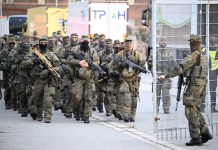Strengthening civil defense response in the wake of Russia’s invasion of Ukraine and return of conventional war to Europe, Switzerland has decided to modernise thousands of nuclear bunkers scattered across the country.
But why does it have so many bunkers, despite its historically neutral status?
Since Russia invaded Ukraine, social media has been flooded with visuals of Ukrainians hiding in military bunkers to escape the drones and missiles raining over their cities.
These images, especially in the early days of the war, captivated public imagination across Europe and resurrected the need for bunkers that could be used in case war knocked at their doors. Several European countries, such as Germany and Romania, as well as Norway, have already undertaken initiatives to revamp wartime bunkers.
The Swiss army has called on tech firms, researchers, and start-ups in the country to assist in transforming its old wartime bunkers into cutting-edge defense facilities through creative and affordable solutions, according to EuroNews. The goal is to reevaluate the role of Swiss bunkers located throughout the nation and how best to modernise them in light of increased security concerns brought on by the Ukraine war.
Most of these bunkers have been virtually dormant since at least the 1990s, when the Cold War ended with the dissolution of the Soviet Union, and the threat of war gradually receded from the European continent.
The Curious Case Of Swiss Bunkers
If there is anything as intrinsic to Swiss chocolate, cheese, and the Alps, it is the thousands of bunkers across the country.
Initially, bunkers were built as fortifications in 1886 to fend off foreign invasions. While its mountainous terrain makes it a natural fortress, its proximity to major global flashpoints necessitated a robust civil defense infrastructure.
The bunker system was initially constructed to protect critical areas, such as the Gotthard railway and the Alpine passes. During World War II, it was an integral part of the Swiss National Redoubt, a network of fortifications designed to repel an invasion.
However, as the Cold War began and the West and the Soviet bloc started the development of sophisticated nuclear weapons, Switzerland started to prepare to be caught in the middle of a potential nuclear clash. This laid the groundwork for civil defense bunkers throughout the country.
With a population of around 9 million, Switzerland has more bunkers per person than any other country in the world. This means that in the event of a conflict or a military contingency, every single individual would have a place to hide.
Nuclear bunkers, according to nuclear expert Stephen Herzog, are “built into the Swiss psyche.” “Pretty much all Swiss people have a bomb shelter, which has been used for a long time as their storage unit,” Herzog told As It Happens host Nil Köksal. “Now there are reasons to rethink this.”

To safeguard the country’s survival, the government gave civil defense top priority. Swiss law, specifically the 1963 Civil Protection Act, required every home and apartment building to include a bunker capable of withstanding nuclear fallout and blasts.
This applied to all new constructions, and existing buildings had to be retrofitted or have access to communal shelters. The law also strictly mandated that every new residential structure must have an on-site bunker, or developers must set aside money for a state-maintained public bunker near residential communities.
A network of bunkers in the country’s mountains can shield soldiers and people from the devastating effects of nuclear weapons to an unprecedented degree. It is difficult, if not impossible, to guess that nuclear weapons shelters are buried deep in the mountains beneath buildings, dunes, or thick bushes in the forest, their entrances concealed, making them nearly invisible. They are called bunkers, but in reality, they are two-meter-high concrete walls and windows with holes for guns.
The law mandates that each person should have at least one square meter of space. Furthermore, they should be located within a maximum of 30 minutes’ walking distance or 60 minutes’ walking distance in mountainous areas from their homes. Consequently, more than 300,000 bunkers intended to keep civilians safe underground for a few hours to two weeks were constructed.
The existing bunkers have a shelf life of 40 years and come with ventilation systems that could suppress the effects of radiation, nuclear fallout, and chemical and biological warfare.
The Civil Defense in the country explains that “the solid outer shell of the shelter can withstand at least 10 tons of pressure per square meter, which means it can withstand the collapse of a building on it.”

Developers and property owners bear the majority of the maintenance and construction costs per person, which are similar to the annual fees for Swiss health insurance.
Bunker capacity ranges from 50 to 200, and the price per spot has historically been around 1,400 Swiss francs, or around 3,000 Swiss francs for smaller bunkers. During peacetime, most Swiss use them as wine cellars, storage facilities, or saunas.
A second type of bunker, known as a command post, is designed for extended stays and features amenities such as kitchenettes, showers, and internet access for emergency personnel and civil protection personnel who oversee operations.
The period following the end of the Cold War saw a shift in priorities and economic restraints, making it difficult to maintain thousands of bunkers for military use.
As a result, several of these sites, which were previously under the control of the Swiss government, were sold to civilians—some of them were transformed into hotels, some into art galleries, and some were used for storage. Some others, like the Swiss Fort Knox in the Bern canton, were even converted into high-security cryptocurrency vaults.
Following the outbreak of the Ukraine War, the Swiss Army halted these sales in 2023 to determine the best way to repurpose them.
“We have to make use of what we’ve got,” Swiss Army Chief Thomas Süssli told the local media at the time. “The nature of military threats has changed. The bunkers are poorly placed, and the weapons they contain will only last for another ten or twenty years,” he added.
Revamping The Good Old Swiss Bunkers
Though the bunkers have been dormant and used as storage spaces by most Swiss people, the Ukraine War stirred an urgent sense of insecurity among civilians, who frantically began to inquire about the status of public bunkers. Louis-Henri Delarageaz, civil protection commander for the Vaud canton, said his office received a surge in calls from worried residents about shelters after Russia invaded Ukraine in 2022.
Moreover, many of them did not know which bunker to take shelter in, presenting a new challenge in civil defense.
“The bunker you should go to will be close to your home,” Daniel Jordi, deputy director of the Federal Civil Protection Office, told BBC Urdu. “But it’s normal for families to move or relocate. Knowing where their shelter is can be a little overwhelming for them. Is it old? Is it new? We’re just saying that it’s something to talk about when it’s necessary.”

This also served as an impetus for the shift in policy, and the government decided to restore the bunkers and make them usable in the event of a contingency.
In light of the changing global security situation, the Swiss government plans to upgrade its network of underground bunkers, investing US$500 million to modernize it. To ensure that the bunkers are operational and ready for use in an emergency. Officials have stressed that improving shelters is not a preparation for war but an investment in public safety.
The inspections of these bunkers, conducted every 10 years by the Swiss government, have revealed that many of them require upkeep and upgrades. This is how the decision to modernize the bunkers was made, and funds were allocated.
Some cantons (a Swiss administrative unit comparable to a province) have already converted civilian shelters into temporary housing for refugees. Using state-of-the-art technology, the army hopes to transform these bunkers into “difficult-to-attack defence nodes” while ensuring that the upgrades are cost-effective and require minimal manpower.
The Swiss Society for Technology and Armed Forces plans to host an “Innovation Day” in mid-September, where attendees can present their ideas. ”We’re looking for ideas from all sectors, not just defence,” the STA noted.
The Swiss decision to upgrade and revive its Cold War-era nuclear bunkers is under the spotlight because the country swears by “neutrality” in foreign policy, and has managed to remain far from the shadows of war. However, it is the Swiss ‘self-defense’ philosophy that is reflected in bunkers, which ensure that the nation can defend its population independently in the event of a nuclear, chemical, or conventional conflict.
- Contact the author at sakshi.tiwari9555 (at) gmail.com
- Follow EurAsian Times on Google News




